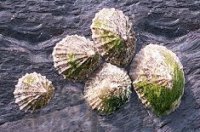 Limpets are found covering rocks and rock pools all around the coasts of New Zealand. They live in the middle and upper part of the tidal zone.
Limpets are found covering rocks and rock pools all around the coasts of New Zealand. They live in the middle and upper part of the tidal zone.
Limpets are distinctive shelled animals that are best known for their ability to cling onto rocks.
Many people believe that they achieve this feat by sucking onto the rocks, but this is not true. They have a strong muscular foot, and they use this to grab small imperfections in the rock surface, and grasp very strongly.
In the second world war there was a mine that was placed on underwater structures such as ships that bears the same name (limpet mine).
The Limpets shell is secreted from a fold of tissue called the mantle. Special muscles attach the limpet to its shell at the base of the point.
The overall shape of the limpet combined with the powerful suction of its foot allows the animal to withstand the constant pounding of the waves and surf of the lower tidal zone, the area of the shore just below the barnacles.
There are a group of false limpets. Many of which are unrelated such as the Siphon Shells and other limpet like molluscs with a similar body shape.
Limpets have a distinctive, oval or cup shaped shell, with a peak (or point) pretty much towards the centre.
When it is high tide, the limpets move about grazing on algae. Limpets use a long thin tube like toothed tongue or radula to rasp algae off the rocks.
As the tide drops, they usually return to their original resting place. Several marine scientists have observed this behaviour.
Many limpets have lost their second gill, and the one single gill projects to the right side of the body.
In all limpets the mantle has developed a considerable overhang, so that there is a groove which runs around the inside of the shell called the Mantle Groove. It is through these two grooves that the water current flows.
The incoming water, called inhalant respiratory current, enters the mantle cavity.
Part of the current flows down the left side, but the main more direct current flows over the gill followed by the excretory organs and the anus, and then down the right mantle groove.
The limpets are one of the foods eaten by starfish.